Participatory Assessment, Monitoring and Evaluation (PAME) is an idea whose time has come. It offers new and promising ideas for sustainable and appropriate community forestry development.
PAME "flips" the traditional "top-down" development approach to a "bottom-up" approach which encourages, supports and strengthens communities' existing abilities to identify their own needs, set their own objectives, and monitor and evaluate them.
The he PAME approach focuses on the relationship between the beneficiaries and field staff and the beneficiaries and the community. It builds on two-way communication, clear messages, and a joint commitment to what "works" for the community.
PAME is a combination of three interlinked parts: the IDEA, the METHODS and the TOOLS. While it may not always be possible to adopt the whole PAME approach in every project, it is possible to experiment with some activities to see if PAME works. Try it, adapt it, play with the ideas presented here, and observe the effects.
Sustainable development can be built on the foundation that PAME sets out, especially when approached with the sense of adventure and creativity that is called for by new ways of thinking!
Chapter One : Getting the idea
1. Changes in community forestry.
2. What is PAME?
3. The principles of PAME.
4. The benefits of PAME.
5. Where will PAME work ?
6. When can PAME begin ?
7. Changing ideas about community development.
8. PAME builds on two-way communication.
1. Changes in community forestry.
In the first stage

In the past twenty years Community Forestry has gone through two very definite stages, and is now entering a third stage.
The outsiders made most of the decisions. They decided what the problems were, and how to solve them. They designed the project and set the project objectives and activities. They provided the necessary inputs, management, and then monitored and evaluated, to see that their objectives and activities had been achieved.
The results were not encouraging. Community interest often decreased over time. Very seldom were activities continued by the community after the outsiders withdrew. It became clear that sustainability was not being achieved.
The outsiders still made most decisions, but they began to ask insiders more questions. Overall, the outsiders role was much like that in the first stage, except that studies of the community done by outsiders to help them establish the needs of the community, offered new insights into community preferences and motivation.
The result was that outsiders began to realize that insiders knew a great deal. Insiders could often identify why activities had or hadn't worked.
In the second stage
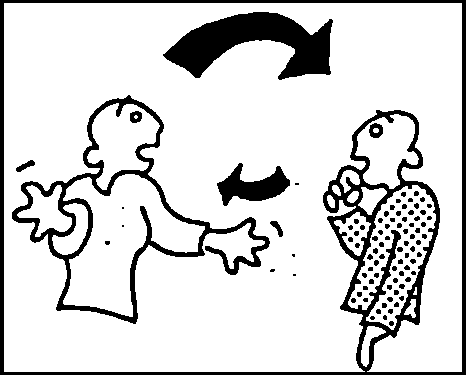
In the third stage
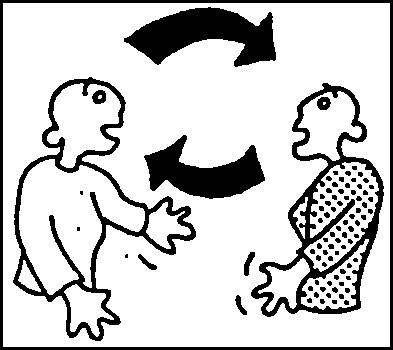
Insiders, with support from outsiders, are active in decision making. Insiders identify their problems and the solutions. They set objectives and activities, monitor and evaluate progress to see these are being achieved, and continue to be relevant. Outsiders adopt a participatory approach, encouraging insiders to identify their own needs, set their own objectives, manage, monitor and evaluate the activities.
The results are promising. The participatory approach has begun to show encouraging results. With time and experience, this approach will continue to develop methods and tools, which hold great potential for sustainable development.
The Community's Toolbox describes some of the participatory methods and tools which can help field staff and communities to further develop this third stage.
Participatory Assessment, Monitoring and Evaluation (what we will refer to as PAME) is a creative and adaptive information system which is based primarily on the information needs of the insiders.
Based on insiders point of view
When insiders make decisions, they must have good information available. PAME encourages and supports an information system that responds to what insiders need to know. But PAME also assumes that while people are actively trying to cope with their problems, they cannot have perfect knowledge or understanding of their political, economic or social situation. Effective development is more than "asking the people themselves-; it is a process of helping them formulate their own questions.
The PAME approach does not assume that the "insiders points of view" are all going to be the same, but information from PAME can aid negotiations between conflicting points of view.
PAME links information to decision-making
Making good decisions requires timely, relevant understandable and accurate information. PAME provides beneficiary and community decision makers with the information they need. Field staff must also make decisions regarding the community. The communities' information needs and field staff information needs may be very similar, especially when both parties objectives are to make changes that will improve conditions in the community.
Decision makers at the national and international level can also benefit from PAME. It can provide them with an analysis which reflects the reality of the community.
FAME considers the whole picture
PAME provides the opportunity to analyze both the qualitative and quantitative information, thus providing more complete information on which to base decisions.
Often, an information system focuses on only numbers (quantitative) information, but numbers alone produce an incomplete picture of what is really taking place in the community.
In the following example, only the quantitative information was known to evaluators, and decisions were made on this basis. If the "story behind the numbers" had been available to them, a different evaluation might have been made.
FAME considers the whole picture
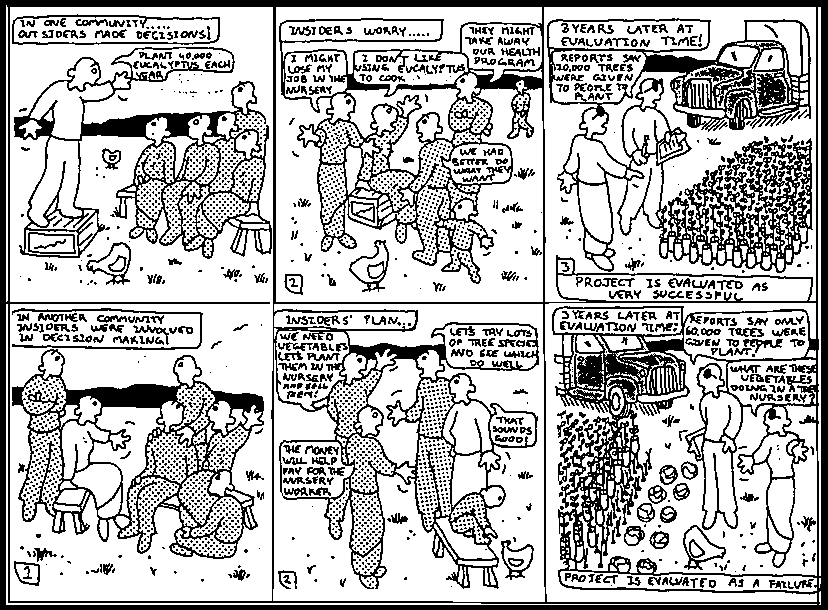
PAME is experimental
PAME is experimental

Each community is unique. Different information is required. Different ways of processing information are needed. There is no blueprint, and no two PAME information systems are going to look alike.
Although there are many examples of successful use of the ideas, methods and tools presented in "The Community's Toolbox", they have not until now been put together. Nor have participatory methods been tried in all cultures.
When you understand the approach used in "The Community's Toolbox", filter it through your own experiences. Be critical, but constructive. Think about adapting the approach if necessary.
PAME is made up of three parts
The ideas, the methods and the tools work together to support each other. PAME will not work very well if the new methods and tools are introduced, without the new ideas; or if the ideas of participation are introduced with methods and tools which do not encourage participation
1. New idea
• outsiders encourage insiders to find their own answers.
• outsiders are encouraged to respond \ to the needs identified by the insiders.
• outsiders and insiders see themselves as partners.
• insiders are the implementers and managers of the project.
2. New methods
• insiders and outsiders jointly determine what information is needed.
• analysis and feedback is done in a way that encourages insider input and thus ensures insider understanding.
• deeper understanding of the project is possible because the whole picture \is considered.
3. New tools
• two-way communication is encouraged.
• a range of possible tools ensures that tools appropriate to the community can be chosen.
• traditional information gathering is considered and/or fried before tools are introduced.
PAME has been built on a number of overall principles which will help you understand the PAME approach.
| Tools chosen to fit community PAME seeks to find the appropriate tool for each unique community. |
| Information that is useful rather than perfect It is often only necessary to have information that shows trends rather than statistically exact information. Information showing trends and delivered on time is often more useful to decision makers than precise information delivered late. |
| Outsiders help community to focus on a specific issue Outsiders facilitate but do not direct. |
| Attitude of partnership Insiders and outsiders can both contribute to community development. |
| Supports existing community skills PAME builds on existing community skills. |
| Essential information PAME seeks to identify information that is "necessary to know" rather than "nice to know". This ensures that the information system is not overloaded with unnecessary information. |
| Two way communication and clear messages PAME is built on ideas, methods and tools that support equal and clear communication between insiders and outsiders. |
| The community is the final evaluator Since it is the community alone who decides whether or not to continue the project, they are the final and most important evaluators. |
| People who make decisions need timely, reliable and useful
information The right information at the right time will facilitate better decisions. |
Empowers insiders
With PAME, people are encouraged and supported to take control of decisions that affect their environment, building the courage and commitment to take part in other decisions. They also develop important contacts with those outside their community so that they can seek advice on their own. Sustainability is more likely to be achieved because insiders develop the skills, contacts and confidence that are necessary to continue after outsiders leave.
Provides checks and balances for development
Insiders take the greatest risks, not only because they give their time and labour, but more importantly, because they have the most to gain or lose. PAME gives insiders the opportunity to explore the risks, the costs and the benefits. In this way they are better prepared to decide whether the activities provide them with the development they want.
Provides timely information
Information gathering and analysis are done at the community level and therefore information is available to the community when decisions are made. When information is timely, potential problems can be identified and remedies can be sought early.
Provides accurate and understandable information
With PAME, information is produced and validated by insiders, who are accountable to one other. This helps assure that information is accurate and reliable.
Information from PAME is understandable to community members because they have determined what information is needed and how it will be analyzed and presented.
Provides cost effective information
When outsiders monitor and evaluate activities the costs are often very high, and the impact of the activities may still not be well understood. PAME provides the opportunity for insiders to communicate their analysis of activities to outsiders. Costs are reduced because only essential information is sought, collected and analyzed.
Benefits both the insiders and the outsiders
Good information is available to both insider and outsider decision makers. Insiders who hope to gain directly from the activities are able to clearly see the costs and benefits. Insiders who may gain or lose indirectly can see the costs and benefits of their support. Outsiders can respond more readily to the real needs of the community.
Identifies community research needs
When insiders decide what information is important to them, their immediate and most important research needs can be identified. These needs can be addressed by community research or outside research agencies. Field staff can play an important role, presenting community identified research questions to higher research institutions and bringing research results back to the community.
Provides a direct line from community to outside decision makers
PAME can present a realistic picture of the community that includes both quantitative and qualitative information. This lessens the chance of poor communication between the community and outside decision makers.
Provides a new way to look at old problems
PAME can provide insiders with new analytical skills which open up new approaches to old problems, shedding light on new solutions.
The focus does not have to be forestry
While PAME has been developed to apply to community forestry, it can be adapted to work in other fields such as health care, watershed management, irrigation, agriculture, fisheries, and projects which integrate forestry and nutrition.
The PAME approach will work in most communities, in most countries, and over a wide range of activities.
PAME will work differently in each culture
Some cultures may have political, religious and cultural systems that lend themselves to the participatory approach. Introducing PAME in these cultures may be relatively easy. Other cultures are more "top-down" with strict rules regarding interaction between individuals or groups. Participatory methods may be more difficult to introduce in these situations and may require more time and commitment on the part of both insiders and outsiders. There may also be great variation within cultures. What may be common to all communities is the wish to influence the process of development, continuing to improve the situation, with or without the assistance of outsiders.
Communities are seldom harmonious groups of people. They are often characterized by deep resentment, grudges and open hostilities. While total community agreement is not always possible, PAME encourages cooperation through focus groups, information sharing, and open negotiations.
PAME can be appropriate to any community forestry activity
Community forestry can include only one activity or many different activities. The difference between community forestry and other forestry activities is that the benefits from forestry stay within the community. These benefits can be gained by individuals or by the community as a whole.
Community forestry can be
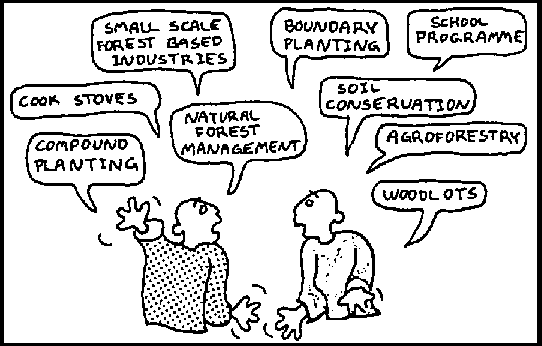
Everybody wants and benefits from sustainable development. But not everybody agrees on the ways to achieve it
Field staff need the support of their supervisors
PAME is introduced to the communities by field staff who must have, or gain the support of their supervisors. It may take extra time for field staff to learn the PAME approach, and develop a dialogue with communities. This may conflict with time frames, work plans and/or targets which are often the responsibility of field staff supervisors. Time frames, work plans and/or targets may have to be modified to accommodate the PAME approach.
If you believe that the PAME approach will benefit the communities, discuss it with your supervisors and try to obtain their support.
PAME can be introduced at any time
Ideally, PAME should be introduced at the early stages of a programme, project or activities. However, benefits are possible at all stages.
| Time | Method used | |
| Beginning | Introduced at the beginning PAME will have the greatest benefit because of the early participation of insiders in planning and design. | • Assessment • Baseline |
| Midway | Introduced midway PAME can provide insight on activities that are not going well so that they can be changed or discontinued. | • Assessment • Baseline • Monitoring • Evaluation |
| End | Introduced towards the end PAME can help the next phase or future activities by identifying the reasons for success or failure from the insiders point of view. | • Evaluation |
7. Changing ideas about community development.
By trying PAME initially in one community field workers can learn more about the approach and how to modify or adapt it to suit the community. Additionally the risks of changing an overall strategy are minimized. If the effects are satisfactory, field staff and community members will have gained experience, and can pass their experience on to others.
New ideas mean change
Be patient! Don't give up if the PAME approach doesn't work in the first week! It has been found that some communities, especially those who have "top down" cultures or those who have long term exposure to outsider development programmes have become dependent on outsiders to do the thinking for them. They may not be interested or familiar with attempts to involve them.
Accepting or rejecting new ideas usually means going through a personal "sorting out". We may examine other similar ideas, or our personal experience, and imagine whether or not the new idea makes sense relative to this. We can react very differently to new ideas.
New ideas mean change
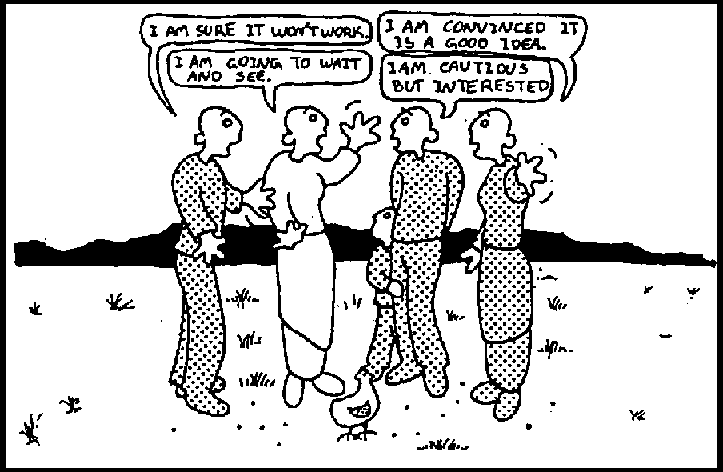
Changing is not easy. Sometimes it means giving up something that is comfortable, such as a definite strategy for community development, even when we know it isn't working very well. Staying with what is comfortable may seem better than risking the unknown.
Accepting new ideas and changing is what "development" is all about! Risking the unknown may be as difficult for some communities as it is for us. People in a community are just like us, comfortable with things the way they are, even if they aren't working well.
PAME offers a new way to look at development
Generally, it is thought that communities participate in OUR activities. This is because in the past outsiders have decided which activities will be conducted. PAME works with a different perspective. Outsiders participate in the activities that belong to the community.
Think of the community as a river which flows on and on. It has flowed for generations, and will continue to flow. As outsiders, we enter the flow of the river (community) at a certain point and exit at another point Hopefully, we leave something positive and lasting with the community. That is sustainable development!
PAME offers a new way to look at development
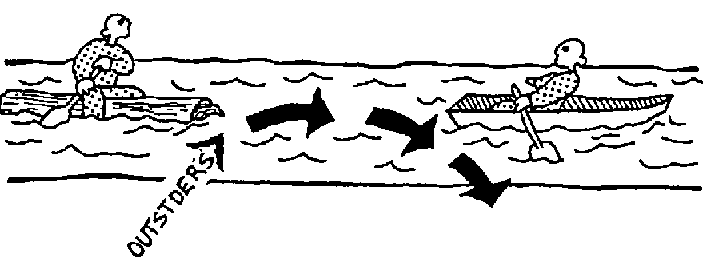
Participatory means partnership
The idea behind PAME is that insiders and outsiders see themselves as equal partners in development, neither one has more control. Insiders and outsiders realize that each will contribute something unique that the other does not possess. They recognize the value of each other's contribution, and that together they can accomplish what neither can do alone.
Participatory means partnership
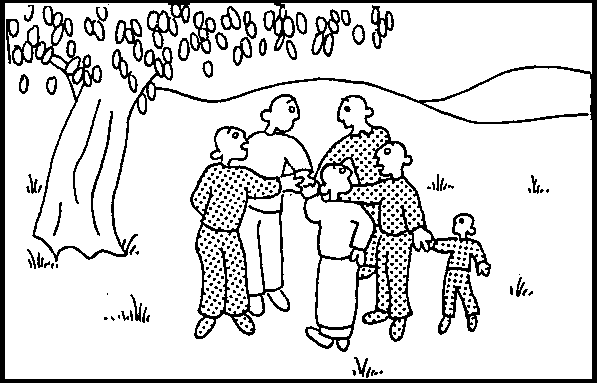
8. PAME builds on two-way communication.
In the following pages there are three exercises for you to go through with your colleges: a communication exercise, a listening exercise and a self-reflection exercise. These can help you to improve your two-way communication skills.
Communication Exercise
Think about your communication training.
Were you trained to have special information that you would then teach others?
How do you share your knowledge?
As trained foresters, agriculturalists, or extensionists we are taught about certain subjects. We are often expected to teach others, and to do this we are trained in one-way communication.
Role playing "teacher" and "student" with your colleagues can be a very effective way of understanding the differences between one-way and two-way communication.
Choose a "teacher" and decide on a subject for the lecture. Try to make it a subject that is more familiar to the "students" than the "teacher".
During the lecture, the "students" are not allowed to contribute. After some time (five or ten minutes) stop the lecture and discuss amongst yourselves what it felt like to be a "student" with knowledge of a subject but without a chance to contribute. Discuss what it felt like to be a "teacher", knowing the "students" had something to contribute but were unable to speak. Then try the role play exercise with the "teacher" encouraging "students".
Communication exercise
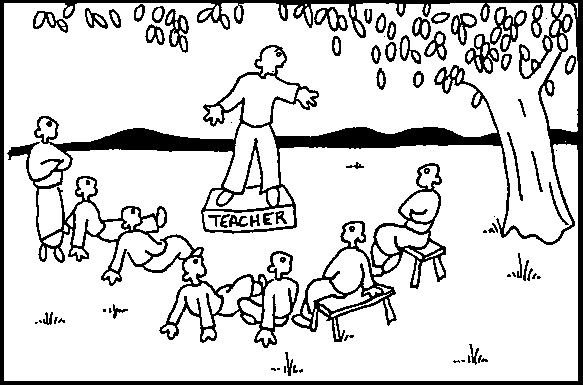
Listening Exercise
Do you communicate well?
Are you most comfortable as a listener or as speaker? Do you ask questions that show you understand what was said, and that you are interested in more information?
Although we are often trained to speak, we are seldom trained to listen. Listening also requires training. Using PAME, it is important to be a good listener. How can we train ourselves to listen and respond in a way that ensures that the other person will come to their own decisions and gain their own insights?
With your colleagues, choose a topic on which opinions are likely to differ. Write a strong statement for both sides of the topic. For example:
"I feel women should not work as foresters."
"I feel women foresters are as effective as male foresters."
or...
"I feel development people from outside the country can never really understand our situation."
"I feel development people from outside the country understand our situation better than we do."
Break into groups of three. Two people will discuss the topic. One of these persons will be a "sender" of the message (Whichever opinion they wish to support), the second person will be a "receiver", trying only to understand the "sender's" point of view. The third person will be a "critic", observing the "sender" and the "receiver". After five minutes, stop the conversation and ask for feedback from the "critic":
Did the responses of the "receiver" criticize the "sender" ? Were the responses supportive of the "sender" ? Did the responses probe for more information? Did the "receiver" seem bored?
The most effective response is one which communicates to the "sender" that the "receiver" is interested in the "sender" as a person, has an accurate understanding of what has been said, and encourages the "sender" to go on, elaborate and further explore the topic.
Change "roles" until everyone has had a turn being a "receiver".
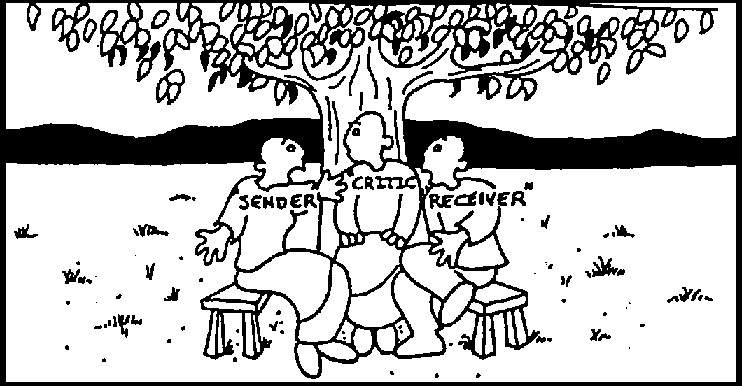
Self Reflection Exercise
How did you communicate today?
Did you feel people enjoyed talking with you?
Did you talk as much as you listened?
What did you learn?
How could you have communicated better?
Good two-way communication takes some time to develop. It can be nurtured by continual reflection, by asking yourself and those around you how you are doing (asking them to be a "critic" ).
Allow some time during field staff meetings to talk about experiences in communication. Discuss communication that worked and communication that did not work. We often learn more from our mistakes, although they are sometimes more difficult to talk about!
At the end of a working day, perhaps on the way home from work, take some time to think about the conversations you had with people. Do you think they went well? What could you have done better? If you are working with colleagues, ask them to give you some feedback. Do the same for them.
Self reflection exercise
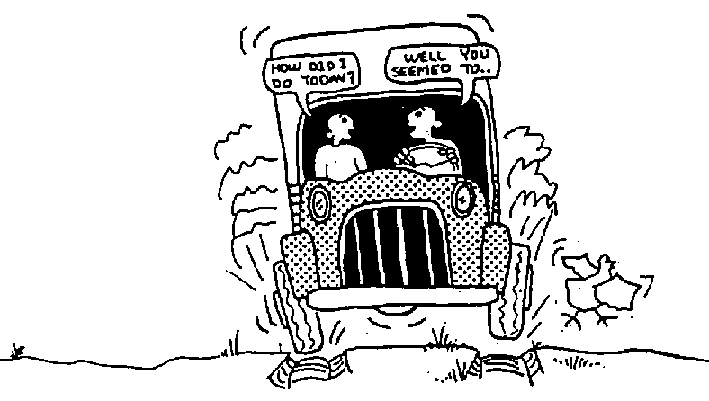
Ask community members how you are doing. You could have them do the S.W.OL. Analysis (Tool 18) on your performance. This is a good exercise because it recognizes that there will be BOTH strengths and weaknesses in your performance.
Being aware of different kinds of communication, learning to listen, and being aware of how you are doing, are the first steps toward two-way communication.